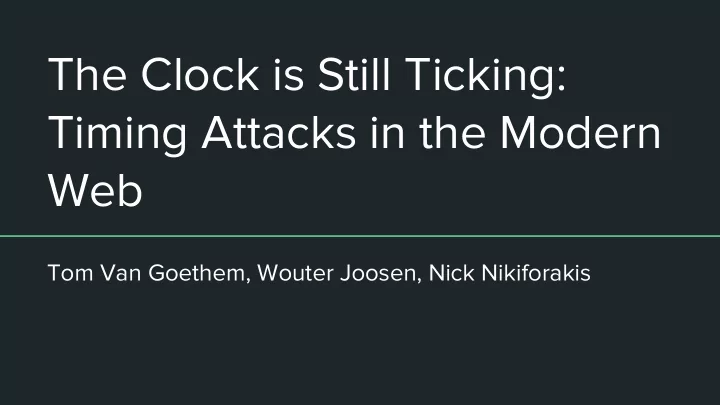

The Clock is Still Ticking: Timing Attacks in the Modern Web Tom Van Goethem, Wouter Joosen, Nick Nikiforakis
Background: Timing attacks ● Introduced by Felten et al. in 2000. A side-channel attack analyzing the time that it takes to a cryptographic ● algorithm/requesting a webpage/etc.
Background: Timing attacks ● Introduced by Felten et al. in 2000. A side-channel attack analyzing the time that it takes to a cryptographic ● algorithm/requesting a webpage/etc. ● If someone has recently visited a particular website, then cache will store it.
Background: Timing attacks ● Introduced by Felten et al. in 2000. A side-channel attack analyzing the time that it takes to a cryptographic ● algorithm/requesting a webpage/etc. ● If someone has recently visited a particular website, then cache will store it. ● Cache will save time the next time the website is requested, where attackers can analyze the time difference and get valuable information.
Timing attacks in modern web ● This paper proposes new timing attacks using modern web features (HTML5, etc).
Timing attacks in modern web ● This paper proposes new timing attacks using modern web features (HTML5, etc). ● Purpose of attacker in this paper is a bit different: estimate the size of a resource.
Timing attacks in modern web ● Basic version: Image object is useful. ● The image src is set to be an HTML page, which will eventually result in error when the image object parses it. ● The onError function will always be called
Advanced versions of timing attack in web ● Using audio or video object instead of image.
Advanced versions of timing attack in web ● Use audio or video object instead of image. (HTML5 feature) Use ApplicationCache: attacker can force an external resource to be cached ● ○ Although reading a small file takes less than 1ms, the size of a file still has measurable influence on reading from cache.
Advanced versions of timing attack in web ● Use audio or video object instead of image. (HTML5 feature) Use ApplicationCache: attacker can force an external resource to be cached ● ○ Although reading a small file takes less than 1ms, the size of a file still has measurable influence on reading from cache. ● Use Service Worker: allow time measuring even after user closes browser ○ Service Worker: event-driven scripts whose lifetime is independent of the webpage Use Fetch API to perform network requests, can make authenticated requests without CORS ○ ○ A process running in background
Advanced versions of timing attack in web ● Use audio or video object instead of image. (HTML5 feature) Use ApplicationCache (modern browser feature): attacker can force an ● external resource to be cached ○ Although reading a small file takes less than 1ms, the size of a file still has measurable influence on reading from cache. ● Use Service Worker: allow time measuring even after user closes browser ○ Service Worker: event-driven scripts whose lifetime is independent of the webpage (A process running in background) ○ The time it takes to put a resource in cache and remove it from cache can be used by attacker. ● Use script parsing
Performance of different timing attacks in web ● Performance of these timing attacks:
Discussion: real-world timing attacks ● Facebook: Age, Gender and Location may be leaked by phishing Facebook page can post to a specific group of users (age 20-30/female only/etc.) ○ ○ Page can post several times with different user group, where the content is a permanent phishing website URL, and different targeted user will see different URL. ○ After the user gets into the website, timing attacks can be performed against private info..
Discussion: real-world timing attacks ● LinkedIn: Contact Search If a user has many connections from Germany, then he or she is likely living in Germany. ○ ○ Query for contacts uses XMLHttpRequest(XHR) and JSON stream, response size depends on the connection numbers., ○ Timing attack can measure and estimate the number of connections
Discussion: real-world timing attacks ● Twitter: Protected accounts Google and Amazon: Search History can be investigated ● ● Many more...
Discussion: defensive approaches ● Randomized accessing time implemented on browser (client-side) But that may affect performance ○ ● Server side CSRF countermeasures ● What else?
Discussion: Significance ● The above examples show that timing attack can be very harmful toward our private information
Discussion: Significance ● The above examples show that timing attack can be very harmful toward our private information ● However, not a bad way for big data companies/institutions to obtain data. ○ Very crucial in researches. May actually improve people’s life.. ○
Discussion: Significance ● The above examples show that timing attack can be very harmful toward our private information ● However, not a bad way for big data companies/institutions to obtain data. ○ Very crucial in researches. May actually improve people’s life.. ○ ● The question is: privacy information or machine learning benefits?
Future Works on Timing attack ● Effective and efficient defensive approaches (Is that possible?) The ethical question ●
Questions?
Recommend
More recommend